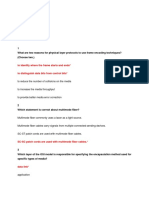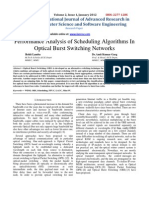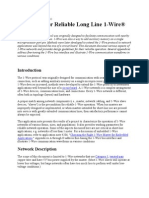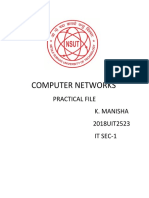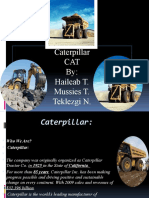Application Note 1-Wire Basics Ver. 1.0: Logic IO
Application Note 1-Wire Basics Ver. 1.0: Logic IO
Uploaded by
nedoredCopyright:
Available Formats
Application Note 1-Wire Basics Ver. 1.0: Logic IO
Application Note 1-Wire Basics Ver. 1.0: Logic IO
Uploaded by
nedoredOriginal Title
Copyright
Available Formats
Share this document
Did you find this document useful?
Is this content inappropriate?
Copyright:
Available Formats
Application Note 1-Wire Basics Ver. 1.0: Logic IO
Application Note 1-Wire Basics Ver. 1.0: Logic IO
Uploaded by
nedoredCopyright:
Available Formats
Application Note 1-Wire Basics Ver. 1.
www.logicio.com
Jyllandsgade 54, 8700 Horsens, DK
Logic IO
Application Note 1-Wire Basics Ver. 1.0
Application Note 1-Wire Basics Ver. 1.0
www.logicio.com
Jyllandsgade 54, 8700 Horsens, DK
Logic IO
This application note describes how to configure and use the Maxim/Dallas Semiconductors 1-Wire products with the Logic IO RTCU units. The document will explain some basic 1-wire hardware configuration. Currently the supported 1-wire products are the iButton 1 identification key and a temperature sensor. Other products may be supported in future please consult Logic IO for more information. All the supported 1-Wire products are available directly from Logic IO.
The iButton is a unique, factory-lasered and tested 64-bit registration number that assures absolute traceability because not two parts are alike. It comes in a small metal MicroCan that is very robust even in harsh environments. In order to read the iButton a special reader must be used. The reader is attached to the 1-wire bus and connects the iButton to the 1-wire bus. A small key-ring (iButton Fob) adapter is available so the iButton is easier to carry and place in the reader. The temperature sensor is a small wide-range (55C to +125C) temperature sensor, which needs no external power (it derives its power directly from the 1-wire bus, called parasitic power). This makes it very easy to do remote temperature sensing in various places.
Its important to understand that the bus is a very complex thing, even though it only consist of two wires; the communication form and the communication speed will set a high demand for correct cabling and loading of the bus. Every 1-wire network behaves differently due to the variation in cable length, the amount of devices (load) on the bus and the surrounding environment. When configuring 1-Wire hardware and transmission lines (the 1-wire bus) certain terminologies are used. These terms are circuit topology, radius and weight. Circuit topology is the way to describe how the circuit is coupled. There are three topologies Linear, stubbed and star. RTCU Unit Figure 1, linear topology network RTCU Unit
Hardware
Figure 2, stubbed topology network
1-Wire and iButton are registered trademarks of Maxim/Dallas Semiconductors.
Logic IO ApS. Jyllandsgade 54 8700 Horsens Denmark
Page 2 of 4 Ph: (+45) 7625 0210 Fax: (+45) 7625 0211 Email: info@logicio.com www.logicio.com / www.rtcu.dk
Application Note 1-Wire Basics Ver. 1.0
www.logicio.com
Jyllandsgade 54, 8700 Horsens, DK
Logic IO
RTCU Unit Figure 3, star topology network The three topologies will behave differently due to signal reflections etc. The most reliable topology is the linear topology but sometimes its not possible to obtain this topology. When the three topologies are mixed the circuit becomes even more complex and its very hard to predict how reliable the network will be. Other terms like radius and weight are used to describe the length and load of the 1-wire bus. The radius describes the total length of the bus. The 1-wire protocol has a radius limitation of 750-meters due to timing, but the RTCU-unit supports only a total radius of approximately 65-metes. If a linear topology is used and four devices are attached each with 1-meter space in-between the total radius of the network is the length to the furthest device i.e. 4-meter. 1m RTCU Unit Figure 4, weight and radius of the network The weight of the network consists of two things; the total amount of cable and the number of devices. Every time a 1-wire device is attached to the network it adds some weight due to its capacitance. An iButton add a weight of 1-meter and a temperature sensor adds 0,5-meter. In the linear topology case the weight of the cable would be 4-meter and with four temperature sensors attached the total weight will be 6-meters. The RTCU unit is designed only for short and medium range networks. As mentioned earlier the RTCUunit supports a radius of approximately 65-meters and a maximum weight of 65-meters. When a linear topology is used it is possible to have 64,5 meters cable and a single temperature sensor. See examples in the table 1 below.
Max Weight [m] Cable [m] 65 64,5 65 57 65 49 Device Weight [m] 0,5 = 1 temperature Device 8 = 16 temperature Device 16 = 32 temperature Device Total Weight [m] 65 65 65
1m
1m
1m
Table 1, examples on how to determine the weight of a 1-wire network
The total weight of the network must not exceed the maximum allowed weight i.e. 65m. The bus should not be routed together with high power signals like the mains supply or other equipment that will have electrical influence on the 1-wire signal.
Logic IO ApS. Jyllandsgade 54 8700 Horsens Denmark Page 3 of 4 Ph: (+45) 7625 0210 Fax: (+45) 7625 0211 Email: info@logicio.com www.logicio.com / www.rtcu.dk
Application Note 1-Wire Basics Ver. 1.0
www.logicio.com
Jyllandsgade 54, 8700 Horsens, DK
Logic IO
The cable has to be a Category 5 twisted pair copper wire. Other cables can be used but the radius and weight capabilities are highly reduced. Please note RTCU-A9i Max units before serial number x41001000 (x can be the number 1,2 or 3) only supports: 6 temperature devices. Maximum network radius of 20 meters Maximum weight of 20 meters Its advisable to read the Maxim Application note App Note 148: Guidelines for Reliable 1-Wire Networks which can be downloaded from www.maxim-ic.com. For 1-wire software functions and examples please consult the online documentation supplied with the RTCU IDE program.
As mentioned earlier the 1-wire network is very complex and sensitive for interruptions. If an interrupt or any interactions interfere with the bus while a communication or a device search is performed it may result in an erroneous reading, termination of device search or devices that are not discovered and/or accessed correctly. The more often a 1-wire device search is done the more its likely that a device is left out due to interrupts on the bus. This will for the temperature sensors result in a different organized list of ROM-numbers and the user will experience a reading of another temperature sensor than expected or an -1 error (device not known) if it was the device with the highest ROM-number that was left out.
Please Notice and be aware of
Logic IO ApS. Jyllandsgade 54 8700 Horsens Denmark
Page 4 of 4 Ph: (+45) 7625 0210 Fax: (+45) 7625 0211 Email: info@logicio.com www.logicio.com / www.rtcu.dk
You might also like
- Computer Network Lab Lab Manual: Prepared By: Eng. Sireen HiaryDocument80 pagesComputer Network Lab Lab Manual: Prepared By: Eng. Sireen HiaryHamdallah Anwar KhasawnehNo ratings yet
- Solution of Exercise Sheet 2Document10 pagesSolution of Exercise Sheet 2mkgoel1234No ratings yet
- Necesidades Par Colocar Varios DS18B20 Sensores Sobre Un Mismo CableDocument18 pagesNecesidades Par Colocar Varios DS18B20 Sensores Sobre Un Mismo CableRo VictorNo ratings yet
- OSI Physical Layer SupplementDocument147 pagesOSI Physical Layer SupplementAndy MorrisonNo ratings yet
- Home Work 1: Class: M.C.A Section: D3002Document14 pagesHome Work 1: Class: M.C.A Section: D3002Dushyant SinghNo ratings yet
- Whitepaper Single Pair EthernetDocument13 pagesWhitepaper Single Pair EthernetLarry HughesNo ratings yet
- IGNOU MCA MSC-042 Solved Assignments 2010Document11 pagesIGNOU MCA MSC-042 Solved Assignments 2010Anirban SarkarNo ratings yet
- Overview of FieldbusDocument24 pagesOverview of FieldbusMussoorieNo ratings yet
- Design 2Document25 pagesDesign 2Fatih Mehmet FerahNo ratings yet
- Cables - White Paper Technical Specifications and CharacteristicsDocument7 pagesCables - White Paper Technical Specifications and CharacteristicsTeuku RizkyNo ratings yet
- 2005 DeviceNet Quick Start FinalDocument7 pages2005 DeviceNet Quick Start FinalSolange Antonio CarlosNo ratings yet
- Capter 4Document8 pagesCapter 4newNo ratings yet
- Exp1 Cabling and WiresharkDocument21 pagesExp1 Cabling and WiresharkCharles CarpenterNo ratings yet
- Chapter 4Document15 pagesChapter 4Okech MableNo ratings yet
- Iiot Question BankDocument28 pagesIiot Question Bankdarshan KeskarNo ratings yet
- Study The Physical Media of Connectivity: Practical No. 1Document40 pagesStudy The Physical Media of Connectivity: Practical No. 1Ram SharmaNo ratings yet
- Performance Analysis of Scheduling Algorithms in Optical Burst Switching NetworksDocument5 pagesPerformance Analysis of Scheduling Algorithms in Optical Burst Switching Networkseditor_ijarcsseNo ratings yet
- Altex FO OHL Sensing SystemDocument4 pagesAltex FO OHL Sensing SystemtdropulicNo ratings yet
- Philips 3C85 Ferrite MaterialDocument9 pagesPhilips 3C85 Ferrite Materialcatalin0827No ratings yet
- Wireless Safety - App Guide - 01Document9 pagesWireless Safety - App Guide - 01DIGI-TRON BalançasNo ratings yet
- Computer Networking Lab Manual 2023-24Document42 pagesComputer Networking Lab Manual 2023-24deepthim135No ratings yet
- Transmission Media & Networking Components: Electrical Engineering DepartmentDocument11 pagesTransmission Media & Networking Components: Electrical Engineering DepartmentHazel Ann ManlapazNo ratings yet
- بروتوكولات الشبكةDocument88 pagesبروتوكولات الشبكةmultplaycallofdutyNo ratings yet
- Wireless Data Transfer Using Visible Light CommunicationDocument4 pagesWireless Data Transfer Using Visible Light CommunicationSelva RajNo ratings yet
- TTL and CMOS FamiliesDocument7 pagesTTL and CMOS FamiliesFabian AvilaNo ratings yet
- Man 60363 Modbus En-131505Document18 pagesMan 60363 Modbus En-131505Vijeesh T VargheseNo ratings yet
- 1 Wire App-NoteDocument36 pages1 Wire App-NotehuynhkhoaNo ratings yet
- To Identify Where The Frame Starts and Ends To Distinguish Data Bits From Control BitsDocument6 pagesTo Identify Where The Frame Starts and Ends To Distinguish Data Bits From Control BitsLeonardo Alberto Conde TorresNo ratings yet
- Specification For Otn/Sonet/Sdh Digital Communications Network Tester SystemDocument3 pagesSpecification For Otn/Sonet/Sdh Digital Communications Network Tester SystemahmedelhajsaNo ratings yet
- Paper ID198 PDFDocument6 pagesPaper ID198 PDFZellagui EnergyNo ratings yet
- CN Lab File - 2024Document80 pagesCN Lab File - 2024imamsahil202No ratings yet
- 1-Wire - The Technology For Sensor NetworksDocument4 pages1-Wire - The Technology For Sensor NetworksHenrique ThielNo ratings yet
- Setting-Up Computer Networks (SUCN)Document81 pagesSetting-Up Computer Networks (SUCN)Nerlyn Grace Abajar BosicoNo ratings yet
- Mini ProjectDocument20 pagesMini ProjectSri Sarat ChandraNo ratings yet
- Lucent UMTS Macrocell Compact Product DatasheetDocument2 pagesLucent UMTS Macrocell Compact Product DatasheetPaul ReyesNo ratings yet
- 4-Physical LayerDocument9 pages4-Physical Layerbadri.mohammed55No ratings yet
- Computer Communication (1) - RemovedDocument42 pagesComputer Communication (1) - RemovedAdityaNo ratings yet
- What's The Difference Between The RS-232 and RS-485 Serial Interfaces?Document8 pagesWhat's The Difference Between The RS-232 and RS-485 Serial Interfaces?vairam81100% (2)
- LWP0039-01 Anterix WhitepaperDocument20 pagesLWP0039-01 Anterix WhitepaperVerdierNo ratings yet
- Introduction To Industrial Networks: Unit 3Document31 pagesIntroduction To Industrial Networks: Unit 3Mantenimiento MendezNo ratings yet
- Physical Transmission MediaDocument47 pagesPhysical Transmission MediaabdulazizNo ratings yet
- Project Final Presentation About Solar PanelsDocument18 pagesProject Final Presentation About Solar PanelsSURYAJITH DENNYNo ratings yet
- Midterm Report Group 3Document34 pagesMidterm Report Group 3Zeeshan RafiqueNo ratings yet
- Wireless Transmission of Telemetry Data Via Laser BeamDocument4 pagesWireless Transmission of Telemetry Data Via Laser BeamBijay MaharjanNo ratings yet
- CN PracticalsDocument31 pagesCN Practicalskumarjass5251No ratings yet
- بروتوكولات الشبكة مؤشرة 1Document67 pagesبروتوكولات الشبكة مؤشرة 1multplaycallofdutyNo ratings yet
- Network Management-Module MidtermDocument9 pagesNetwork Management-Module MidtermAlvinNo ratings yet
- Computer Networks: Practical File K. Manisha 2018UIT2523 It Sec-1Document35 pagesComputer Networks: Practical File K. Manisha 2018UIT2523 It Sec-1manishaNo ratings yet
- Ex. No.3Document11 pagesEx. No.3MAYANKNo ratings yet
- TLE Grade8 ICT-CSS Module13Document8 pagesTLE Grade8 ICT-CSS Module13Hazel Mae EbaritaNo ratings yet
- Network Cabling and Devices: Implementation Techniques of Various TypesDocument67 pagesNetwork Cabling and Devices: Implementation Techniques of Various Typescrimefighter31No ratings yet
- Throughput and Delay Analysis of Unslotted IEEE 802.15.4Document9 pagesThroughput and Delay Analysis of Unslotted IEEE 802.15.4Faucon MbémbéNo ratings yet
- The Physical LayerDocument18 pagesThe Physical LayerbonfacesarifNo ratings yet
- Wil S NT K Wil S NT K Wireless Sensor Networks Wireless Sensor NetworksDocument35 pagesWil S NT K Wil S NT K Wireless Sensor Networks Wireless Sensor Networksshekhar358No ratings yet
- Realization of IEC 60870-5-104 Protocol in DTUDocument6 pagesRealization of IEC 60870-5-104 Protocol in DTUKalyan RanjanNo ratings yet
- International Journal of Computational Engineering Research (IJCER)Document11 pagesInternational Journal of Computational Engineering Research (IJCER)International Journal of computational Engineering research (IJCER)No ratings yet
- EEP-Arc Flash Hazard Calculation in 9 Steps Using IEEE 1584-AAADocument6 pagesEEP-Arc Flash Hazard Calculation in 9 Steps Using IEEE 1584-AAAJOSE LUIS FALCON CHAVEZNo ratings yet
- Worksheet 4 - Assignment 1 RevisionDocument12 pagesWorksheet 4 - Assignment 1 RevisionAnthony Neil PaceNo ratings yet
- CN Lab File-1Document51 pagesCN Lab File-1Shreya VermaNo ratings yet
- Arduino Measurements in Science: Advanced Techniques and Data ProjectsFrom EverandArduino Measurements in Science: Advanced Techniques and Data ProjectsNo ratings yet
- Atc Spso ScelDocument2 pagesAtc Spso ScelJose Luis Morales HuamaniNo ratings yet
- PGBP QuestionsDocument6 pagesPGBP QuestionsHdkakaksjsb100% (2)
- 7sept 1948 PDFDocument43 pages7sept 1948 PDFshivalik budhirajaNo ratings yet
- Safety Data Sheet: Section 1. IdentificationDocument11 pagesSafety Data Sheet: Section 1. IdentificationBalaji SNo ratings yet
- III Eee I Sem Cs Lab Manual (Ee332) - 1Document51 pagesIII Eee I Sem Cs Lab Manual (Ee332) - 1Syed Salman AhmadNo ratings yet
- 1.2 ANSWER KEY Evaluation ExamDocument12 pages1.2 ANSWER KEY Evaluation ExamRoivz TriNo ratings yet
- Students Advocating For Homelessness and PovertyDocument6 pagesStudents Advocating For Homelessness and Povertyapi-654955897No ratings yet
- Internship - Report (Vinay Patil L V)Document34 pagesInternship - Report (Vinay Patil L V)Ganesh H SNo ratings yet
- Communication Theory Overall Question BankDocument7 pagesCommunication Theory Overall Question BankECEOCETNo ratings yet
- Ronidel, Rosario S. - Detailed Lesson Plan 2021Document20 pagesRonidel, Rosario S. - Detailed Lesson Plan 2021Rosario CartagenaNo ratings yet
- Manufacturing and MerchandisingDocument2 pagesManufacturing and MerchandisingLayNo ratings yet
- Novartis 2.0Document16 pagesNovartis 2.0Aditya BansalNo ratings yet
- Operation Manual - Fire ActionsDocument5 pagesOperation Manual - Fire ActionsGregorNo ratings yet
- Chrysler CDS System - Bulletin2Document6 pagesChrysler CDS System - Bulletin2Martin Boiani100% (1)
- Chapter 3 Practice QuestionsDocument3 pagesChapter 3 Practice QuestionsFamily PicturesNo ratings yet
- Study Master Natural Sciences and Technology Teachers Guide Grade 6 9781107381063ARDocument151 pagesStudy Master Natural Sciences and Technology Teachers Guide Grade 6 9781107381063ARCaylin RileyNo ratings yet
- MLC v. SpotifyDocument23 pagesMLC v. SpotifyBillboardNo ratings yet
- Golden Rule of InterpretationDocument13 pagesGolden Rule of InterpretationishanNo ratings yet
- Ecommerce Playbook CYDocument27 pagesEcommerce Playbook CYybsme100% (1)
- Writing Concept PapersDocument18 pagesWriting Concept PapersShar Laine100% (2)
- Industrial For Utility Communications: TEBIT Teleprotection and Binary UNIT N4BDDocument4 pagesIndustrial For Utility Communications: TEBIT Teleprotection and Binary UNIT N4BDHuynh NguyetNo ratings yet
- Corporate Responsibilities of MNCs Cases of Human Rights ViolationDocument21 pagesCorporate Responsibilities of MNCs Cases of Human Rights ViolationMohd Imran IdrisiNo ratings yet
- Links To Online Resources: Chapter 1 Science and Technology Inventors and InventionsDocument5 pagesLinks To Online Resources: Chapter 1 Science and Technology Inventors and InventionsMoarz GalaxyNo ratings yet
- Spek Teknis Mesin Anjungan Pencetakan Sertipikat ElektronikDocument1 pageSpek Teknis Mesin Anjungan Pencetakan Sertipikat ElektronikRevalap BPN BulelengNo ratings yet
- General Specifications For Freeways and Toll Roads Final AugDocument552 pagesGeneral Specifications For Freeways and Toll Roads Final AugGen RicNo ratings yet
- Principles of Macroeconomics 10th Edition Solution ManualDocument6 pagesPrinciples of Macroeconomics 10th Edition Solution ManualAhmed Ghanim0% (4)
- Quickmast 341Document2 pagesQuickmast 341osama mohNo ratings yet
- Caterpillar CAT By: Haileab T. Mussies T. Teklezgi NDocument54 pagesCaterpillar CAT By: Haileab T. Mussies T. Teklezgi NHaileabmarketingNo ratings yet
- Accident Investigation & Counter MeasuresDocument40 pagesAccident Investigation & Counter MeasuresabdelrahmanNo ratings yet
- CT V 900 A Manual Instalare Centrala Control Acces 2 Usi Paradox Centaur Position Technology CdviDocument23 pagesCT V 900 A Manual Instalare Centrala Control Acces 2 Usi Paradox Centaur Position Technology CdviMlNo ratings yet











